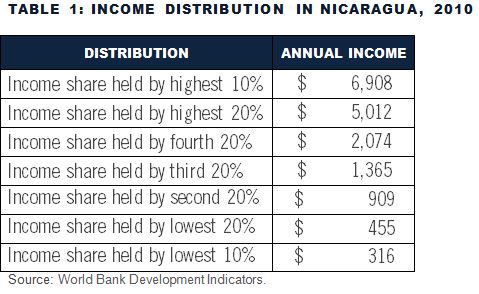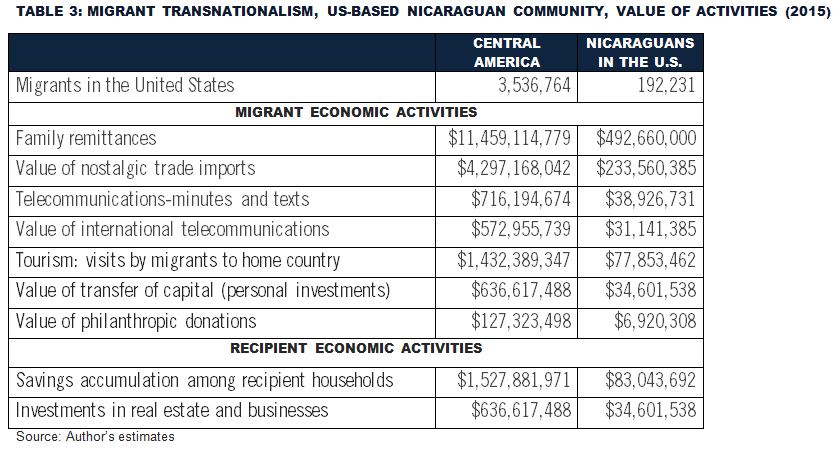Thinking Differently About Nicaragua’s Development Challenges
While Nicaragua’s GDP growth has generally been higher than that of its neighbors, its starting point is that of one of the poorest countries in the Western Hemisphere. Nicaragua’s GDP has grown 3.5% annually over the past five years with per capital GDP of only $2,000 for 2016.[1] This is not enough to get the country out of poverty, nor to limit a continued pattern of outmigration and place the country on a competitive path in the global economy. Nicaragua needs to think outside of the box by leveraging its human capital to the fullest.
Nicaragua’s economy
Growth originates from some of the lowest-paying sectors of the economy, including agriculture, forestry and fishing, which typically pay less than half of the national average.[2] In fact, 60% of the population lives on less than the monthly average minimum wage (US$140) in a country where the monthly basic food basket costs three times that amount. [3] Moreover, 52% of Nicaraguans live in poverty and 29% in extreme poverty.[4]

At the root of this lies a society that is highly unequal with a labor force that is uneducated, unskilled, underpaid, and informal.
Moreover, the Nicaraguan economy is highly dependent on a handful of economic activities, including exports of agricultural commodities and textiles, which together account for more than 72% of all exports.[5] Despite this orientation, only a small number of companies are participating. According to surveys, only 1% of the country’s businesses export to international markets. [6] These businesses are contributing to the country’s GDP significantly, but also concentrating its wealth in few hands, since they tend to be run by leading families.
Most importantly, and paradoxically, labor is the leading source of income generation, but in the form of labor migration.
To a large extent, Nicaragua’s economy is no different from that of the rest of its northern neighbors. But its weakness is deeper and reflected in inequality, high levels of informality and large outmigration. With migrants sending home an estimated at $1.1 billion annually, or 10% of the country’s GDP, the flow of remittances is a mirror image of the large flow of cross-border labor mobility.

Informality in Nicaragua
A closer look at Nicaragua’s business sector helps explain some of the limitations of the country’s economic model. The country’s economy is comprised of an informal labor force and informal businesses, which exhibit low income and low productivity.[7] Three quarters of businesses are in the informal economy,[8] as are roughly three quarters of workers in the labor force.[9]
In most cases, informal businesses generate less than two minimum wages a month or the equivalent of US$240, half of which goes to cover expenses and debts. Because the vast majority of informal businesses (83%) are comprised of only the employer, with no employees, incomes are typically low. In practical terms, informal business and the labor force working for them contribute to one third of the country’s national income but no more. [10]
Informality in Nicaragua is also associated with lower education and higher poverty levels. Amongst individuals working in industries with high levels of informality, in particular the agricultural, mining, and construction sectors, the likelihood of earning less than $2 a day increases two-fold.[11]
In terms of education levels, 54.7% of those managing businesses in the informal sector have either no education or a primary education, compared with 15.6% of those in the formal labor force. Similarly, 12.5% of informal business managers have a university education compared with 50.6% in the formal sector. [12]
Unfortunately, informality is widespread and solutions are not easy to come by. According to a 2015 survey, the main reasons that Nicaraguan businesses do not formalize include lack of interest (38%), difficulty with the procedures (20%), not seeing the “value” of being formal (17%), and the costs of the procedures (15%).[13] Registering a business is not easy in Nicaragua, which has been ranked 125 out of 189 worldwide for Ease of Doing Business.[14] Starting a (formal) business in Nicaragua typically takes 6 procedures, 13 days of work, and costs 72.2% of income per capita (or 17 minimum wages).[15]
Migration and Development in Nicaragua
Nicaraguan foreign labor migration is a byproduct of the poor model of growth, one which precedes the 1980s period when thousands of Nicaraguans left escaping the civil war.
Given the economic asymmetries of Nicaragua and Costa Rica (Costa Rica’s economy and minimum wages are at least five times that of Nicaragua) and a growing international demand for foreign labor in strategically important areas of other countries’ economies, there are more than 700,000 Nicaraguans living and working abroad, particularly in Costa Rica and the United States. These migrants are sending over a billion dollars in remittances. Nearly half of those flows come from Nicaraguans in the United States and the other half from Costa Rica.
These flows are only a part of a larger set of economic engagements that this community establishes with their homeland. The table below shows, for example, that Nicaraguan immigrants in the United States not only send money home but also consume nostalgic products (beans, tortillas, cheese, etc.), call home, visit the country or donate to charitable projects in their home community. In addition, remittance recipients have important stocks of savings and investments they make in their own initiatives.

However, despite these numbers, labor migration is not integrated into the government’s national development plans. Given the magnitude of informality and the extent of wealth generated through migration-related transnational activities, is important to consider new development approaches.[16]
Towards a New Strategic Approach
In the age of the knowledge economy, a central development challenge for Nicaragua is to strengthen the human capital base of their youth and workforce. Education, skills attainment and workforce training are not only precarious but also disconnected from the demands of a competitive labor force in the global economy. Moreover, the labor feels entirely demotivated to stay in their homeland when there are no means to achieve the material circumstances that can be enjoyed in the modern society.
An innovative development strategy integrating migration, remittances, savings and education can help Nicaragua attain greater levels of development and ensure that Nicaraguans have greater opportunities without having to migrate. The approach links migration and development through five unique and innovative components:
- Financial education for remittance recipients,
- Access to credit for small enterprises—especially those in the knowledge economy,
- Promotion of diaspora-driven trade opportunities (the so-called “nostalgia trade”),
- Diaspora funding of education using remittance platforms, and
- After-school programs in areas of high emigration.
However, Nicaraguan economic performance will greatly benefit from efforts to reduce the rate of informality by investing in human capital, helping formalize businesses by increasing credit access, creating efficient economies of scale, and anchoring businesses to already existing corporations. The informal economy may be Nicaragua’s “Achilles Heel,” but its labor force is an opportunity to get the country moving forward.
———————————————————————————————————————————————————————————————————————————-
[1] IMF estimates. Accessed on April 18, 2016.
[2] See “Salario nacional promedio por actividad economica,” Banco Central de Nicaragua, at https://www.bcn.gob.ni/estadisticas/sector_real/mercado_laboral/index.php
[3] https://www.mitrab.gob.ni/documentos/canasta-basica/CBEne2016.pdf
[4] World Bank, 2009 value. For full report, see https://openknowledge.worldbank.org/bitstream/handle/10986/22016/9781464806858.pdf?sequence=6
[5] For more information, see the Harvard CID Atlas of Economic Complexity.
[6] “Encuesta de Empresas Sostenibles Nicaragua 2015,” COSEP and ILO.
[7] Studies in Nicaragua classify a business as formal if it was registered with the Nicaraguan Dirección General de Ingresos and/or the Instituto Nicaragüense de Seguridad Social (INSS).
[8] Medición del Empleo Informal en el Marco de la Encuesta Continua de Hogares (ECH) 2012.
[9] “Encuesta de Empresas Sostenibles Nicaragua 2015,” COSEP and ILO.
[10] “Encuesta de Empresas Sostenibles Nicaragua 2015,” COSEP and ILO.
[11] “Diagnóstico del entorno de negocios de Nicaragua, 2015. ILO. Pg. 137.
[12] “Encuesta de Empresas Sostenibles Nicaragua 2015,” COSEP and ILO.
[13] https://www.ilo.org/wcmsp5/groups/public/—ed_emp/—emp_ent/—ifp_seed/documents/publication/wcms_456557.pdf
[14] For the full ranking, see https://www.doingbusiness.org/rankings
[15] See “Doing Business 16: Nicaragua Economy Profile,” World Bank, 2016. Available at https://www.doingbusiness.org/data/exploreeconomies/nicaragua/~/media/giawb/doing%20business/documents/profiles/country/NIC.pdf?ver=3
[16] Our next piece will offer an in-depth profile of Nicaraguan migrants in the US and Costa Rica.



















